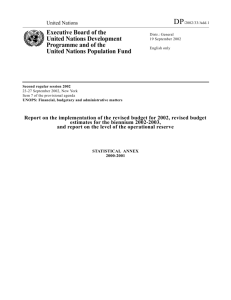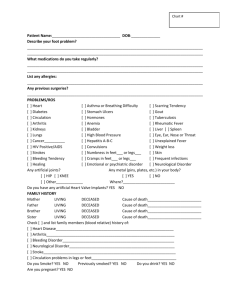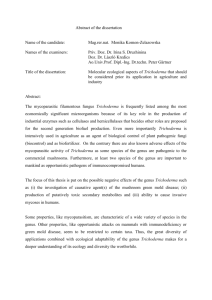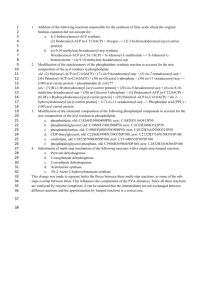Microsoft Word (manuscript)
advertisement
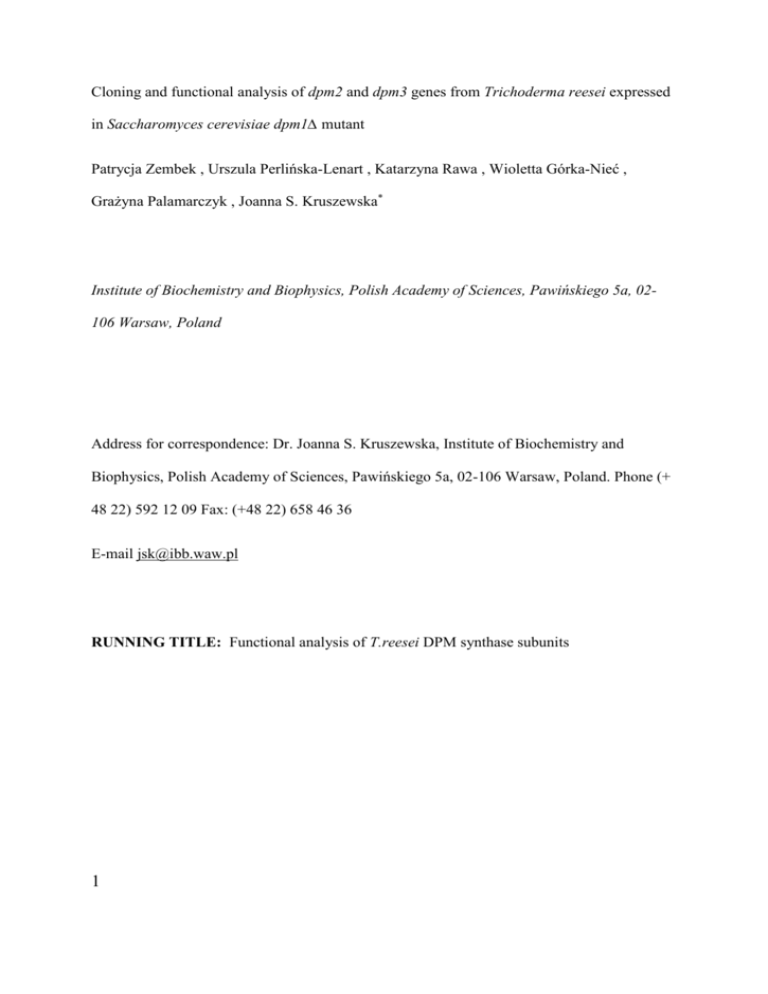
Cloning and functional analysis of dpm2 and dpm3 genes from Trichoderma reesei expressed in Saccharomyces cerevisiae dpm1∆ mutant Patrycja Zembek , Urszula Perlińska-Lenart , Katarzyna Rawa , Wioletta Górka-Nieć , Grażyna Palamarczyk , Joanna S. Kruszewska* Institute of Biochemistry and Biophysics, Polish Academy of Sciences, Pawińskiego 5a, 02106 Warsaw, Poland Address for correspondence: Dr. Joanna S. Kruszewska, Institute of Biochemistry and Biophysics, Polish Academy of Sciences, Pawińskiego 5a, 02-106 Warsaw, Poland. Phone (+ 48 22) 592 12 09 Fax: (+48 22) 658 46 36 E-mail jsk@ibb.waw.pl RUNNING TITLE: Functional analysis of T.reesei DPM synthase subunits 1 SUMMARY In Trichoderma, dolichyl phosphate mannose synthase, a key enzyme in the O-glycosylation process, needs three proteins for full activity. In this study the dpm2 and dpm3 genes coding for the DPMII and DPMIII subunits of Trichoderma DPM synthase were cloned and analyzed functionally after expression in the S.cerevisiae dpm1∆ mutant. It was found that apart from the catalytic subunit DPMI, also the DPMIII subunit was essential to form an active DPM synthase in yeast. Additional expression of the DPMII protein, considered to be a regulatory subunit of DPM synthase, decreased the enzyme activity. We also characterized S.cerevisiae strains expressing dpm1,2,3 or dpm1,3 genes and analyzed the consequences of dpm expression on protein O- glycosylation in vivo and on the cell wall composition. KEY WORDS: Trichoderma; DPM synthase; O-glycosylation; cell wall composition. 2 INTRODUCTION Dolichyl phosphate mannose synthase (DPM synthase) catalyzes the transfer of mannosyl residue from GDP mannose to dolichyl phosphate (DolP) to form dolichyl phosphate mannose (DPM). DPM serves as a donor for protein O-mannosyltransferases in Oglycosylation and for mannosyltransferases elongating the DolPP(GlcNAc)2Man5 oligosaccharide in the N-glycosylation pathway (Orlean 1992; Herscovics and Orlean 1993; Strahl-Bolsinger et al., 1999, Maeda and Kinoshita 2008). DPM also takes part in Cmannosylation and in the synthesis of glycosylphosphatidylinosytol anchor (GPI), and cells devoid of DPM synthase are non viable (Doucey et al., 1998; Orlean 1990). Moreover, limitation in the synthesis of DPM in human cells causes a congenital disorder of glycosylation (CDG) called carbohydrate-deficient glycoprotein syndrome (CDGS); show developmental delay, hypotonia, seizures, and acquired microcephaly (Imbach et al., 2000; Kim et al., 2000, Lefeber et al. 2009). The DPM synthases cloned up to now are divided into two groups. The first group contains Dpm1 proteins similar in structure to the Saccharomyces cerevisiae DPM synthase which is encoded by the DPM1 gene and characterized by a C-terminal transmembrane domain which is absent in the second group of the Dpm1 proteins called the human group. The human group contains synthases from human, rat, Caenorhabditis elegans, Schizosaccharomyces pombe and Trichoderma (Orlean et al., 1988; Colussi et al., 1997; Kruszewska et al., 2000). In human cells DPM synthase is a complex of three proteins, where DPM3 stabilizes the DPM1 protein and DPM3 itself is stabilized by DPM2 (Maeda et al., 2000, Ashida et al. 2006). DPM2 is a hydrophobic protein associated with the hydrophobic N-terminal part of DPM3 (about 60 amino acids). In turn, a hydrophobic C-terminal part of DPM3 (about 30 amino acids) associates with DPM1. Maeda et al. (1998) proposed a model of the DPM synthase 3 complex and described it in detail, showing that for association of DPM1 with DPM2 24 Cterminal amino acids of DPM1and Phe 21 and Tyr 23 from DPM2 were important. Furthermore, DPM3 alone was able to stabilize DPM1 and DPM synthase had an enzymatic activity without the DPM2 subunit, however, the activity was ten-fold higher when DPM2 was present as well. It is not known why in some organisms the structure of DPM synthase is so complex; it has been suggested that a multicomponent system could be more suitable for regulation (Maeda et al., 2000), but a similar system of regulation has been proposed for DPM synthases from both groups. DPM synthase from Trichoderma, like its counterparts from the rat, Aspergillus nidulans, S.cerevisiae or Candida albicans has been shown to be activated in vitro by cAMP-dependent phosphorylation (Kruszewska et al., 1991; Banerjee et al., 1987, 2005; Perlińska-Lenart et al., 2005; Arroyo-Flores et al., 2005). The predicted site of phosphorylation, Ser 152 in Trichoderma, was also found in S.cerevisiae Dpm1 at Ser 141 and is generally conserved in the human and S.cerevisiae classes of DPM synthases (Orlean et al., 1988; Colussi et al., 1997; Kruszewska et al., 2000; Banerjee et al., 2005). A comparison of sequences of Dpm1 proteins has revealed 30% identity between members from different groups and more than 60% identity between Dpm1 proteins from the same group (Kruszewska et al., 2000). Moreover, our interest was stirred up by the presence of the C-terminal hydrophobic domain distinguishing the two groups of Dpm1 proteins. The domain is likely to be a major determinant for the localization of the yeast-type Dpm1 proteins in the endoplasmic reticulum membrane. From our earlier study we know that addition of the Cterminal transmembrane domain from S.cerevisiae Dpm1to the T.reesei DPMI protein creates a chimeric protein which is not functional in S.cerevisiae or bacteria and has a decreased activity when expressed in an S.pombe dpm1 mutant (Kruszewska et al., 2000). This result has led to the conclusion that the transmembrane domain cannot replace the DPMII and 4 DPMIII subunits of Trichoderma DPM synthase and suggested that the enzyme is inactive in vivo on account of being mislocalized. Since organisms belonging to the S.cerevisiae group lack the Dpm2 and Dpm3 subunits of DPM synthase, the Dpm1 protein from the human group cannot replace the Dpm1 protein from the S.cerevisiae group (Tomita et al., 1998; Maeda et al., 1998). Here we expressed DPM proteins from Trichoderma in different combinations in the S.cerevisiae dpm1∆ mutant. We report that apart from the DPMI catalytic subunit also the DPMIII protein is essential for survival of the mutant. Additional expression of the DPMII regulatory protein resulted in the inhibition of DPM synthase activity. As a consequence of the decreased activity of the enzyme, chitinase, a model O-glycosylated protein ,was partially under glycosylated. In addition, the lower-than-normal activity of DPM synthase in yeast strains dpm1,2,3 or dpm1,3 resulted in changes in the cell wall composition which were more pronounced in the triple transformant than in both dpm1,3 and dpm1*3(GAL)-expressing strains. 5 RESULTS Cloning of the dpm2 and dpm3 genes from T.reesei Cloning of the dpm1 gene from Trichoderma (Kruszewska et al., 2000) showed that the encoded DPM synthase belongs to the human group of the enzymes and probably works as a complex of three proteins DPMI, DPMII and DPMIII. Fragments of DNA encoding putative DPMII and DPMIII proteins were synthesized as described in the Methods and sequenced. Sequence analysis of the 240 bp open reading frame (ORF) of dpm2 revealed it encoded a protein of 80 amino acids, a predicted T.reesei DPMII. This protein shows 86% identity and 93% similarity to the Gibberella zeae hypothetical Dpm2 protein and only 54% identity and 78% similarity to the S.pombe Dpm2p (Figure 2). The second ORF of 276 bp encoded a protein of 92 amino acids a predicted T.reesei DPMIII. Analysis of the protein sequence showed 79% identity and 90% similarity to the Dpm3 protein from Gibberella zeae, 64 % identity and 76 % similarity to the Neurospora crassa Dpm3 and only 30% identity and 63% similarity to S.pombe Dpm3p (Figure 2) (Altschul et al., 1997). Phylogenetic trees for the Dpm2 (Figure 3) and Dpm3 (Figure 4) proteins supported the results from protein sequence analysis (Figure 2) showing the closest relationship of Trichoderma with other filamentous fungi. The putative DPMII and DPMIII proteins were analyzed by the TmPred program (Hoffmann et al., 1993) to find potential membrane spanning domains. Hydropathy analysis indicated that, like the human DPM2 protein (Maeda et al., 1998), Trichoderma DPMII is a hydrophobic protein with two predicted transmembrane domains (Figure 2), and analysis by the PSORT II program (http://psort.nibb.ac.jp) revealed a putative 6 ER membrane retention signal, a KKXX-like motif (AKKK) at the C-terminus. Hydropathy profile of the predicted T.reesei DPMIII showed a structure very similar to that of the human DPM3 protein (Maeda et al., 2000) with two membrane spanning domains (Figure 2), a hydrophobic domain at the C-terminus and a putative ER retention signal TRAQ at the Nterminus. In the cloned genomic copies of the two genes we found one intron (82 bp) in the 322 bp sequence of dpm2 and two introns (104 bp and 97 bp) in the 477 bp sequence of dpm3. Expression of the dpm2 and dpm3 genes in S.cerevisiae A yeast diploid strain carrying deletion of one copy of the DPM1gene was transformed with Trichoderma dpm1, dpm2 and dpm3 or dpm1and dpm2 or dpm1and dpm3 genes and selected on -Leu -Ura SC medium. Eleven different combinations of plasmids were used for transformation (Table 2). Transformants were then cultivated on sporulation medium and tetrads dissected. Four viable spores were obtained for S.cerevisiae transformed with non-flagged dpm1,2,3 or dpm1,3 genes. These transformants contained the dpm1 gene under the constitutive GPD promoter. We also isolated one transformant (dpm1*3(GAL)) containing FLAG-dpm1 gene under the GAL1 promoter in combination with non-tagged dpm3 gene. S.cerevisiae dpm1∆ diploid transformed with this combination of genes gave only two or three viable spores. The combination of dpm1and dpm2 genes could not complement the DPM1 deletion, giving only two viable spores containing the original yeast DPM1 gene. Next, the spore clones were analyzed as described in the Methods to confirm the presence of the appropriate dpm genes and finally plasmids isolated from the strains were sequenced. For 7 the subsequent experiments we took the dpm1,2,3, dpm1,3 and dpm1*3(GAL) transformants and a control haploid S.cerevisiae strain containing the native DPM1 gene. Influence of heterologously expressed dpm genes on strain growth and activity of DPM synthase, protein O-mannosyltransferases and mannosyltransferases elongating Olinked sugar The transformants and control strain were cultivated in SC medium with galactose and every 1.5 h absorbtion of the culture was measured (Figure 5). The dpm1,2,3-transformed strain grew more slowly than did the control and dpm1,3 or dpm1*3(GAL) strains. Both dpm1,3, and dpm1*3(GAL)-transformed strains and the control reached stationary phase after 9 h while the dpm1,2,3 transformant required 20 h of cultivation. Next, the strains were cultivated to mid-exponential phase (OD600=1), membrane fractions were isolated and activity of DPM synthase was measured. The membrane fractions were also used for Western analysis of DPMI protein content in the ER of the transformants. The activity of DPM synthase in the membrane fraction from the dpm1,2,3-transformed strain was by 35% lower than the activity from both dpm1,3-transformed strains and the control (Table 3). The decreased activity of DPM synthase in the membrane fraction from dpm1,2,3transformed strain was in agreement with the low amount of DPMI protein detected by Western blot (Figure 6). Since the DPM synthase activity in the dpm1,2,3 transformant was decreased one could expect that this strain produced lower amounts of dolichyl phosphate mannose a crucial substrate for protein O-mannosyltransferases; to check the validity of this assumption activity of protein O-mannosyltransferases was measured. Unexpectedly, despite the lower activity of DPM synthase in the dpm1,2,3 transformant, the activity of protein O-mannosyltransferases 8 was in fact higher by 75% than that in the three other strains (Table 3). On the other hand, a decrease of substrate (DPM) concentration might have been compensated by protein Omannosyltransferases activity or their expression rates. Protein O-mannosyltransferases were only slightly more active (about 12%) in both dpm1,3 transformed strains than in the control and this increase was not statistically significant according to t-Student test. At the same time the activity of mannosyltransferases catalyzing elongation of the O-linked sugar chain was lower by 70 and 26% in the dpm1,2,3 and dpm1,3 strains, respectively, than in the control strain (Table 3). The 9.2% decrease of mannosyltransferases activity in the dpm1*3(GAL) was not statistically significant. Influence of heterologously expressed dpm genes on protein O- glycosylation in vivo The decreased activities of DPM synthase and mannosyltransferases elongating O-linked carbohydrate chain in the dpm1,2,3 transformant suggested that O-glycosylation of some proteins could be altered in this strain. Chitinase, a model O-glycosylated protein, was chosen to examine its O-glycosylation in vivo. We found that chitinase produced by the dpm1,2,3 transformant had a different pattern of electrophoretic mobility compared to those in the dpm1,3- or dpm1*3 (GAL) transformed strains and the control (Figure 7), apparently due to the presence of under-O-glycosylated forms of the enzyme. Influence of heterologously expressed dpm genes on cell wall formation Our previous experience with the impact of DPM1 expression in Trichoderma (PerlińskaLenart et al., 2006) on the cell wall composition prompted us to investigate whether the cell wall composition of the dpm-transformed yeast strains would also be altered. For a simple screen of the cell wall status we cultivated our transformants and the control strain in the presence of Calcofluor white (40 g/ml). Cultivation with Calcofluor white, a fluorochrome dye that binds to chitin in cell walls of fungi, should give proportional effect to the chitin 9 concentration in the cell wall of examined strains. The experiment showed significant differences between the examined strains in their sensitivity to this antifungal agent. The control strain exhibited no sensitivity to Calcofluor white, while the dpm1,2,3-transformed stain was unable to grow in the presence of the drug (Figure 8). Growth of both dpm1,3 and dpm1*3 (GAL) expressing transformants was also not inhibited in the presence of Calcofluor white. These results led us to propose that expression of three Trichoderma dpm genes altered the cell wall composition of the transformant. To investigate these alterations, we measured the content of the cell wall glucans and chitin. The analysis of carbohydrates showed that the amount of β-1,3 glucan in the cell wall of the dpm1,2,3, dpm1,3 and dpm1*3 (GAL) transformants was increased by 17, 12 and 20%, respectively, compared to the control, while the amount of alkali-insoluble β-1,6 glucan was slightly decreased in the transformants. At the same time, the content of chitin was 3.8 and 1.3-fold higher in the dpm1,2,3 and dpm1,3transformed strain, respectively, compared to the control and was unaffected in the dpm1*3 (GAL) transformant (Table 4). DISCUSSION Our earlier studies have shown that DPM synthase from Trichoderma belongs to the human type of the enzymes, where the catalytic DPM1 subunit forms an active complex with two other DPM proteins, DPM2 and DPM3 (Kruszewska et al., 2000; Colussi et al., 1997). In this study we have cloned the dpm2 and dpm3 genes from Trichoderma and analyzed their function by expression in an S.cerevisiae dpm1∆ mutant. Basing on the finding that expression of Trichoderma DPMI protein alone in the S.cerevisiae dpm1∆ mutant could not suppress the mutation (Kruszewska et al., 2000), we transformed a diploid dpm1∆ yeast mutant with different combinations of Trichoderma dpm genes: dpm1 and 2, dpm1 and 3, and 10 dpm1, 2 and 3. Both dpm1 and dpm2 genes were expressed under the GAL1 promoter with the FLAG epitope inserted upstream of the genes, while the dpm3 gene was cloned under the GAL10 promoter and tagged with the myc epitope. Yeast sporulation and tetrad dissection gave only two viable spores containing yeast DPM1 gene showing that expression of the tagged dpm genes did not lead to suppression of the dpm1∆ mutation. The DPM3 protein from the human DPM synthase complex was shown to be associated by its C- and N- terminus with the DPM1and DPM2 subunits, respectively(Maeda et al., 2000). It seemed possible that the FLAG or myc epitopes fused with the DPMI or DPMIII proteins could disturb formation of the DPM synthase complex. To overcome this possible obstacle we transformed yeast dpm1∆ mutant with combinations of tagged and non- tagged genes (Table1). Moreover, dpm1 gene was expressed under two different promoters (see Material and Methods). Viable spores expressing Trichoderma genes were obtained only when expression of dpm1 was driven by the constitutive GPD promoter and when formation of the DPM synthase complex was not disturbed by the FLAG or myc epitop. We observed only one exception when the dpm1∆ mutation was suppressed by the flagged dpm1* gene expressed under the GAL1 promoter in combination with non-flagged dpm3 gene. Western analysis showed that in the dpm1*3(GAL) transformant the amount of DPMI protein was elevated compared to the dpm1,3 transformant where the dpm1 gene was expressed under the GPD promoter. We thus concluded that successful suppression of the dpm1∆ mutation was obtained by expression of non- flagged genes and when the dpm1 gene was expressed under the GPD promoter. The high expression of the flagged dpm1* gene under the GAL1 promoter (dpm1*3(GAL) strain), failed to increase the DPM synthase activity over the control level, despite producing an elevated amount of DPMI protein. 11 Furthermore, our study confirmed that the DPMII subunit was not essential for the functioning of DPM synthase, in contrast to the DPMIII subunit. We did not investigate the possibility of obtaining an active DPM synthase in the absence of DPMI, as the latter is obviously the only catalytically active one. In human cells the DPM1protein stabilized by DPM3 had an enzymatic activity, although in the presence of DPM2 the activity was 10-fold higher (Maeda et al., 2000). Since the DPM2 protein is very hydrophobic the authors suggested that it could facilitate the use of dolichyl phosphate or, being closely associated with DPM3, it could cause a steric change in DPM3 enhancing the enzymatic activity. In our case, expression of Trichoderma DPMI and DPMIII proteins in yeast cells resulted in a higher activity of DPM synthase than expression of all three subunits. This result suggests that the heterologous regulatory signal coming from the DPMII protein was recognized by the yeast cells and somehow limited the activity of the enzyme. Moreover, expression of the DPMII protein in the control strain did not affect the activity of yeast Dpm1 protein (data not shown). This experiment suggested that the DPMII regulatory activity was connected with a direct physical interaction between the Trichoderma DPM synthase subunits. Although the activity of DPM synthase was lower in the dpm1,2,3-transformed strain, the activity of the next enzymes in the O-glycosylation pathway, protein O-mannosyltransferases, was elevated. Paradoxically, Western blotting analysis revealed that the model O-glycosylated protein chitinase was under- O-glycosylated in this strain. This could be a result of the significantly decreased activity of mannosyltransferases elongating O-linked carbohydrate chains in the dpm1,2,3 transformant. 12 Changes in the O-glycosylation of chitinase were often observed as a consequence of limited activity of the O-glycosylation pathway (Agaphonov et al., 2001; 2005; Janik et al., 2003; Kim et al., 2006; Strahl-Bolsinger et al., 1999; Zakrzewska et al., 2003). Shortage of GDPmannose production (Agaphonov et al., 2001) and limited activity of protein Omannosyltransferases (Agaphonov et al., 2005; Strahl-Bolsinger et al., 1999) as well as blocked activity of DPM synthase (Janik et al., 2003) resulted in the production of under-Oglycosylated chitinase or, for an S.cerevisiae dpm1-6 mutant, a totally un-O-glycosylated form. The lower activity of DPM synthase in the yeast transformants studied here affected also the cell wall composition. On the other hand, a higher activity of DPM synthase in Trichoderma also influenced the cell wall composition (Kruszewska et al., 1999; Perlińska-Lenart et al., 2006). These findings combined show that proper activity of DPM synthase is crucial to the cell wall status. Here we found that the decreased activity of this enzyme caused small changes in the glucan content and a significant elevation of chitin level. Similarly the cell wall of the yeast dpm1-6 mutant had the content of chitin increased by 64% and an unchanged content of glucans (Orłowski et al., 2007). Variations in glycosylation often correlated with activation of the cell wall integrity pathway manifested by increased synthesis of chitin (Strahl-Bolsinger et al., 1999; Lommel et al., 2004; Orłowski et al., 2007). In this study we cloned and characterized functions of the dpm2 and dpm3 genes from Trichoderma. Characterization of the dpm1,2,3, dpm1,3 and dpm1*3 (GAL) transformed yeast strains proved that we did clone subunits of Trichoderma DPM synthase. Furthermore, we showed that the DPMII regulatory subunit decreased the activity of Trichoderma DPM synthase expressed in yeast. Moreover, we showed that the decreased activity of DPM 13 synthase in the dpm1,2,3-transformed strain resulted in specific changes in the Oglycosylation of chitinase and influenced the formation of the cell wall components. We believe that our observations might be useful in better understanding of the O-glycosylation process in yeast and Trichoderma. MATERIAL AND METHODS Strains and growth conditions T.reesei QM 9414 (ATCC 26921) was used for DNA isolation. Escherichia coli strain DF’ was used for plasmid propagation (Yanish-Perron et al., 1985). T.reesei was cultivated at 30°C on a rotary shaker (250 rpm) in 2 l shake flasks containing 1 l of minimal medium (MM): 1 g MgSO4 x 7H2O, 6 g (NH4)2SO4, 10 g KH2PO4, 3 g sodium citrate x 2H2O and trace elements (25 mg FeSO4 x 7H2O, 2.7 mg MnCl2 x 4H2O, 6.2 mg ZnSO4 x 7H2O, 14 mg CaCl2 x 2H2O) per liter and 1% (w/v) glucose as a carbon source. S.cerevisiae BY4743 diploid strain carrying deletion of DPM1 (YPR183w) gene was used for expression of dpm1, dpm2 and dpm3 genes from Trichoderma (NCBI Acc. No.: dpm1 AF102883; dpm2 - GQ200738; dpm3 - GQ200739). The yeast strain was bought in Euroscarf (Y25598; genotype BY4743; Mat a/; his31/his31; leu20/leu20; lys20/LYS2; MET15/met150; ura30/ura30; YPR183w::kanMX4/YPR183w). Yeast strains were grown in SC medium (Sherman 1991) with the necessary supplements and for sporulation 1% potassium acetate pH 7 and 2% bacto-agar was used. Galactose was used at 2% as a carbon sources. Cloning of dpm2 and dpm3 genes from T. reesei 14 Sequences of putative dpm2 and dpm3 genes were found in the genomic data base of Trichoderma (http://genome.jgi-psf.org/Trire2/Trire2.home.html) using sequences of dpm2 and dpm3 genes from Botryotinia fuckeliana (NCBI Acc. No.: dpm2 - XM 001556879; dpm3 - XM 001561034), Gibberella zeae (XM 387389; XM 388453) and Neurospora crassa (XM 951284; XM955413). DNA fragments encoding putative Trichoderma DPMII and DPMIII proteins were amplified by PCR using T. reesei QM9414 genomic DNA or cDNA as templates and specific primers (Table 1). The amplified DNA was cloned into the pGEM T-Easy vector (Promega) and sequenced. Expression plasmids cDNA fragments of 240 bp and 276 bp coding for DPMII and DPMIII, respectively, amplified as above using Trichoderma cDNA library as template were ligated together or separately into the multiple cloning vector pESC-URA (Stratagene). Putative Trichoderma dpm2 and dpm3-encoding cDNAs were amplified primers using dpm2U2 and dpm2F2 or dpm3U2 and dpm3F2, respectively (Table 1). The genes were cloned under the GAL1/GAL10 (galactokinase/ UDP glucose 4-epimerase) divergent promoters in cloning sites 1 (dpm2) and 2 (dpm3) using restriction sites BglII/PacI for dpm2 gene and XhoI/KpnI for dpm3. This way of cloning allowed us to fuse DPMII and DPMIII proteins with the FLAG and myc-tag, respectively. To clone the genes without the tags under the same promoters, BamHI/HindIII and EcoRI restriction sites were used for dpm2 and dpm3 genes, respectively. The respective cDNA was amplified using dpm2U and dpm2F or dpm3U and dpm3F primers (Table 1). For expression of T.reesei dpm1gene in S.cerevisiae, a cDNA fragment of about 810 bp containing the dpm1 open reading frame was amplified by PCR using dpm1U2 and dpm1F2 primers and cloned into the pESC-LEU vector (Stratagene) under the GAL1promoter and the 15 CYC1 (cytochrome-c-oxidase) terminator in cloning site 2 using XhoI/NheI restriction sites and fused with the myc-tag. The dpm1 gene amplified with the dpm1U3 and dpm1F2 primers was also cloned under the GAL1 promoter in cloning site 2 using digestion with BamHI/NheI to remove the myc-tag. Next, dpm1 c DNA was amplified using dpm1U and dpm1F primers (Table 1) and cloned into the p415 GPD LEU plasmid under the GPD (glyceraldehyde-3phosphate dehydrogenase) promoter and the CYC1 (cytochrome-c-oxidase) terminator (Munberg et al., 1995). For yeast transformation, the one-step transformation method of Chen et al. (1992) was used. The diploid yeast strain carrying deletion of one copy of the DPM1gene was transformed with Trichoderma dpm1 and dpm2, dpm1, dpm2, and dpm3, or dpm1 and dpm3 genes and selected on -Leu -Ura minimal medium. Transformants were then cultivated on the sporulation medium and tetrads dissected. Spore clones carrying disruption of the yeast DPM1 gene were selected on plates containing Geneticin (200 g/ml). From the selected strains plasmids were isolated as described (Hoffman and Winston 1987) and used to transform E. coli DH5F. The plasmids were digested with BglII/PacI, XhoI/KpnI, XhoI/NheI, BamHI/HindIII, BamHI/NheI or EcoRI to analyze the inserts of dpm2, dpm3 and dpm1genes, respectively. The restriction analysis was confirmed by sequencing. Standard techniques (Sambrook et al., 1989) were used for isolating and analyzing plasmid DNA. A control haploid strain was obtained from non-transformed diploid BY4743dpm1∆ by sporulation and taking a viable spore clone containing native DPM1 gene. Molecular biology methods 16 Chromosomal DNA was isolated from T. reesei using the Promega Wizard Genomic DNA Purification kit. Total RNA was isolated using the single-step method described by Chomczynski and Sacchi (1987). Other molecular biology procedures were performed according to standard protocols (Sambrook et al., 1989). For Northern analysis, 10 g of total RNA was loaded onto agarose gel, blotted and hybridized with the whole T.reesei dpm1, dpm2 or dpm3 genes. A control hybridization was performed with a 0.6 kb fragment of the yeast ACT1(actin encoding) gene. The radioactive probes were prepared using [32P] dATP and the Fermentas HexaLabel Plus DNA labeling system according to the standard Fermentas protocol (Figure 1). Biochemical methods Protein assay Protein concentrations were estimated according to Lowry et al. (1951). Enzyme activity assays Membrane preparation and DPM synthase activity S.cerevisiae strains were cultured at 30oC in 1 l of SC-Leu -Ura medium to OD600=1; the cells were then harvested by centrifugation and resuspended in 25 ml of 150 mM Tris buffer pH 7.4 containing 15 mM MgCl2 and 9 mM 2-mercaptoethanol. The suspension was homogenized with 0.5 mm glass beads in a bead beater and the homogenate was centrifuged at 4 000xg for 10 min to remove unbroken cells and cell debris. The supernatant was centrifuged for 1 h at 50 000xg and DPM synthase activity was assayed in the pelleted membrane fraction (about 100g protein) by 5 min incubation at 30oC with GDP[14C]- 17 mannose (sp.act. 288 Ci/mol, Amersham) and 5 ng of dolichyl phosphate (Dol-P), according to Kruszewska et al. (1989, 1999). Enzymatic activity of protein O-mannosyltransferases S.cerevisiae strains were cultured and membrane fraction was prepared as described above. Protein O-mannosyltransferase activity was assayed in the pelleted membrane fraction by 1 h incubation at 30oC with GDP[14C]-mannose (sp.act. 288 Ci/mol, Amersham) and 5 ng of dolichyl phosphate (Dol-P), according to Kruszewska et al. (1989). Total membrane proteins (about 300g) were used as the sugar acceptor. The first mannosyl residue was transferred from GDP[14C]Man via DPM (dolichyl phosphate mannose) in the presence of 10 mM MgCl2 for 1 h (Sharma et al., 1974). To activate the elongation of the O-linked sugar chain the reaction mixture was supplemented with 10 mM MnCl2 and the reaction was carried out for 1 h. Radioactivity was measured in the protein fraction. The elongation of the sugar chain was calculated as the difference between the amount of radioactive mannose bound to the protein in the presence of MnCl2 (the first mannosyl residue and the elongation) and of the mannose transferred in the presence of MgCl2 (only the first mannosyl residue transferred) (Sharma et al., 1974) . Immunodetection of DPMI protein Total membrane fraction use for activity assay was also examined for the concentration of the DPMI protein by immunostaining with monoclonal antibody against S.cerevisiae Dpm1p (Molecular Probes, Eugene, OR, USA). Membrane proteins (200 g) were subjected to the 10% SDS PAGE then transferred to the Immobilon P membrane (Milipore) and Trichoderma DPMI protein detected by immunological reaction with S.cerevisiae Dpm1 antibody. 18 Immunoreactive material was detected using an anti-mouse IgG secondary antibody conjugated to alkaline phosphatase (Sigma). Immunodetection of chitinase Yeast cultures were grown to the logarithmic phase, washed with 50 mM Tris-HCl, pH 7.4, 50 mM MgCl2 and broken with glass beads in the same buffer. Cell walls were centrifuged down at 3000xg and the pellet was resuspended in the same buffer. Cell wall proteins (about 100 g per lane) from the resulting pellet were separated by SDS-PAGE on a 6% gel. Chitinase was detected by immunostaining with an antibody against the deglycosylated protein EC 3.2.1.14 (a gift from Prof. Widmar Tanner, Lehrstuhl für Zellbiologie und Pflanzenphysiologie, Universität Regensburg, Germany) ( Kuranda and Robins 1991; Immervoll et al., 1995). Immunoreactive material was detected using an anti-rabbit IgG secondary antibody conjugated to horseradish peroxidase (HRP) (DAKO). Isolation of the cell wall Cells were grown in medium containing 2% galactose (supplemented with appropriate amino acids) at 28oC. Logarithmic cell cultures (OD600=1) (100 ml) were harvested by centrifugation, washed with water and resuspended in 400 μl water and broken with glass beads. The glass beads were removed and the cell free extracts were centrifuged (1000x g for 15 min). The supernatants were discarded and the pellets, containing the cell wall, were lyophilized. Analysis of the cell wall components For alkali-insoluble β-glucan determination, isolated cell walls were treated with 3% NaOH three times for 1 h at 75oC to remove mannoproteins and alkali soluble glucan. The cell walls were then neutralized by washing twice with 0.1 M Tris–HCl, pH 7.4, followed by 10 mM 19 Tris–HCl, pH 7.4. The alkali-insoluble fraction was digested overnight in 10 mM Tris–HCl, pH 7.4, containing 5 mg/ml zymolyase 20T (ICN Biomedicals Inc.). Subsequently, insoluble material was removed by centrifugation at 18 000 × g for 15 min). After dialysis of the zymolyase-solubilized material, β1,6-glucan was collected and quantified by the method of Miller et al. (1960). Total alkali-insoluble glucan was determined as reducing sugars content before dialysis by the method cited above. The alkali-insoluble β1,3-glucan level was calculated by substraction of the β1,6-glucan content from that of total glucan. For chitin measurements alkaline hydrolysis of cell walls was performed in 6% KOH for 90 min at 80oC in order to release cell wall proteins. After neutralization with acetic acid, the cell walls were washed with phosphate-buffered saline and chitinase buffer, pH 6.0, containing 18 mM citric acid and 60 mM dibasic sodium phosphate. Subsequently, the cell walls were treated with chitinase C (InterSpex Products) for 3 h at 37o C. The level of chitin was measured with Ehrlich’s reagent as described (Reissig et al., 1955). 20 ACKNOWLEDGMENTS We wish to thank Prof. Markku Saloheimo from VTT, Finland for the cDNA bank from Trichoderma and Prof. Robert Mach and Dr. Kurt Bunner from Vienna University of Technology, Austria for the analysis of genomic data bases and designing primers. We also thank Dr. Jacek Lenart from The Museum and Institute of Zoology, PAS, Warsaw for preparation of phylogenetic trees. This work was partially supported by the State Committee for Scientific Research (KBN), Warsaw, Poland, grant No. 1307/P01/2006/31 to J.S. Kruszewska. 21 LITERATURE Altschul, S.F., Madden, T.L., Schaffer, A.A., Zhang, J., Zhang, Z., Miller, W., and Lipman, D.J. (1997). Gapped BLAST and PSI-BLAST: A new generation of protein database search programs. Nucleic Acids Res. 25, 3389-3402. Agaphonov, M.O., Sokolov, S., Romanova, N.V., Sohn, J., Kim, S.Y., Kalebina, T.S., Choi, E.S., and Ter-Avanesyan, M.D. (2005). Mutation of the protein-Omannosyltransferase enhances secretion of the human urokinase-type plasminogen activator in Hansenula polymorpha. Yeast 22, 1037-1047. Agaphonov, M.O., Packeiser, A.N., Chechenova, M.B., Choi, E., and Ter-Avanesyan, M.D. (2001). Mutation of the homologue of GDP-mannose pyrophosphorylase alters cell wall structure, protein glycosylation and secretion in Hansenula polymorpha. Yeast 18, 391-402. Arroyo-Flores, B.L., Calvo-Mendez, C., Flores-Carreon, A., and Lopez-Romero, E. (2005). Biosynthesis of glycoproteins in the pathogenic fungus Candida albicans: Activation of dolichol phosphate mannose synthase by cAMP-mediated protein phosphorylation. FEMS Immunol. Med. Microbiol. 45, 429-434. Ashida, H., Maeda, Y., and Kinoshita, T. (2006). DPM1, the catalytic subunit of dolicholphosphate mannose synthase, is tethered to and stabilized on the endoplasmic reticulum membrane by DPM3. J. Biol. Chem. 281, 896-904. Banerjee, D.K., Carrasquillo, E.A., Hughey, P., Schutzbach, J.S., Martınez, J.A., and Baksi, K. (2005). In vitro phosphorylation by cAMP-dependent protein kinase up-regulates recombinant Saccharomyces cerevisiae mannosylphosphodolichol synthase. J. Biol. Chem. 280, 4174-4181. 22 Banerjee, D.K., Kousvelari, E.E., and Baum, B.J. (1987). c-AMP mediated protein phosphorylation microsomal membranes increases mannosylphosphodolichol synthase activity. Proc. Natl. Acad. Sci. USA 84, 6389-6393. Chen, D., Yang, B., and Kuo, T. (1992). One-step transformation of yeast in stationary phase. Curr. Genet. 21, 83-84. Chomczynski, P., and Sacchi, N. (1987). Single-step method of RNA isolation by acid guanidinum thiocyanate-phenol-chloroform extraction. Anal. Biochem. 162, 156-159. Colussi, P.A., Taron, C.H., Mach, J.C., and Orlean, P. (1997). Human and Saccharomyces cerevisiae dolichol phosphate mannose synthases represent two classes of the enzyme, but both function in Schizosaccharomyces pombe. Proc. Natl. Acad. Sci. USA 94, 7873-7878. Doucey, M., Hess, D., Cacan, R., and Hofsteenge, J. (1998). Protein C-mannosylation is enzyme-catalysed and uses dolichyl-phosphate-mannose as a precursor. Mol. Biol. Cell 9, 291-300. Herscovics, A., and Orlean, P. (1993). Glycoprotein synthesis in yeast. FASEB J. 7, 540-550. Hoffman, C.S., and Winston, F. (1987). A ten-minute DNA preparation from yeast efficiently releases autonomous plasmids for transformation of Escherichia coli. Gene 57, 267272. Hofmann, K., and Stoffel, W. (1993). TMbase - A database of membrane spanning proteins segments. Biol Chem Hoppe-Seyler 374, 166. Imbach, T., Schenk, B., Schollen, E., Burda, P., Stutz, A., Grünewald, S., Bailie, N.M., King, M.D., Jaeken, J., Matthijs, G., Berger, E.G., Aebi, M., and Hennet, T. (2000). 23 Deficiency of dolichol-phosphate-mannose synthase-1causes congenital disorder of glycosylation type Ie. J. Clin. Invest. 105, 233-239. Immervoll, T., Gentzsch, M., and Tanner, W. (1995). PMT3 and PMT4, two new members of the protein-O-mannosyltransferase gene family of Saccharomyces cerevisiae. Yeast 11, 1345-1351. Janik, A., Sosnowska, M., Kruszewska, J., Krotkiewski, H., Lehle, L., and Palamarczyk, G. (2003). Overexpression of GDP-mannose pyrophosphorylase in Saccharomyces cerevisiae corrects defects in dolichol-linked saccharide formation and protein glycosylation. Biochim. Biophys. Acta 1621, 22-30. Kim, M.W., Kim, E.J., Kim, J., Park, J., Oh, D., Shimma, Y., Chiba, Y., Jigami, Y., Rhee, S.K., and Kang, H.A. (2006). Functional characterization of the Hansenula polymorpha HOC1, OCH1, and OCR1 genes as members of the yeast OCH1 mannosyltransferase family involved in protein glycosylation. J. Biol. Chem. 281, 6261-6272. Kim, S., Westphal, V., Srikrishna, G., Mehta, D.P., Peterson, S., Filiano, J., Karnes, P.S., Patterson, M.C., and Freeze, H.H. (2000). Dolichol phosphate mannose synthase (DPM1) mutations define congenital disorder of glycosylation Ie (CDG-Ie) J. Clin. Invest. 105, 191-198. Kruszewska, J., Butterweck, A.H., Kurzątkowski, W., Migdalski, A., Kubicek, C.P., and Palamarczyk, G. (1999). Overexpression of the Saccharomyces cerevisiae mannosylphosphodolichol synthase – encoding gene in Trichoderma reesei results in an increased level of protein secretion and abnormal cell ultrastructure. Appl. Environm. Microbiol. 65, 2382-2387. 24 Kruszewska, J., Messner, R., Kubicek, C.P., and Palamarczyk, G. (1989). O-glycosylation of proteins by membrane fraction of Trichoderma reesei QM9414. J. Gen. Microbiol. 135, 301-307. Kruszewska, J., Palamarczyk, G., and Kubicek, C.P. (1991). Mannosyl phosphodolichol synthase is activated by protein kinase dependent phosphorylation in vitro. FEMS Lett. 80, 81-86. Kruszewska, J.S., Saloheimo, M., Migdalski, A., Orlean, P., Penttilä, M., and Palamarczyk, G. (2000). Dolichol phosphate mannose synthase from the filamentous fungus Trichoderma reesei belongs to the human and Schizosaccharomyces pombe class of the enzyme. Glycobiology 10, 983-991. Kuranda, M.J., and Robins, P.W. (1991). Chitinase is required for cell separation during growth of Saccharomyces cerevisiae. J. Biol. Chem. 266, 19758-19767. Lefebre, D.J., Schonberger, J., Morava, E., Guillard, M., Huyben, K.M., Verrijp, K., Grafakou, O., Evangeliou, A., Preijers, F.W., Manta, P., Yoldiz, J., Grunewald, S., Spilioti, M., van den Elzen, C., Klein, D., Hess, D., Ashida, H., Hofsteenge, J., Maeda, Y., van den Heuvel, L., Lammens, M., Lehle, L., and Wevers, R.A. (2009). Deficiency of Dol-P-Man synthase subunit DPM3 bridges the congenital disorders of glycosylation with the dystroglycanopathies. Am. J. Hum. Genet. 85, 76-86. Lommel, M., Bognat, M., and Strahl, S. (2004). Aberrant processing of the WSC family and Mid2p cell surface sensors in cell death of Saccharomyces cerevisiae O-mannosylation mutants. Mol. Cell. Biol. 24, 46-57. Lowry, O.H., Rosebrough, N.J., Farr, A.L., and Randall, R.J. (1951). Protein measurement with the Folin phenol reagent. J. Biol. Chem. 193, 265-275. 25 Maeda, Y., and Kinoshita, T. (2008). Dolichol-phosphate mannose synthase: structure, function and regulation. Biochim. Biophys. Acta 1780, 861-868. Maeda, Y., Tomita, S., Watanabe, R., Ohishi, K., and Kinoshita, T. (1998). DPM2 regulates biosynhesis of dolichol phosphate mannose in mammalian cells: correct subcellular localization and stabilization of DPM1 and binding of dolichol phosphate. EMBO J. 17, 4920-4929. Maeda, Y., Tanaka, S., Hino, J., Kangawa, K., and Kinoshita, T. (2000). Human dolicholphosphate-mannose synthase consists of three subunits, DPM1, DPM2 and DPM3. EMBO J. 11, 2475-2482. Miller, G.L., Blum, R., Glennon, W.E., and Burton, A.L. (1960). Measurements of carboxymethylcellulase activity. Anal. Biochem. 2, 127-132. Orlean, P., Albright, C.F., and Robbins, P.W. (1988). Cloning and sequencing of the yeast gene for dolichol phosphate mannose synthase, an essential protein. J. Biol. Chem. 263, 17499-17507. Orlean, P. (1990). Dolichol phosphate mannose synthase is required in vivo for glycosyl phosphatidylinositol membrane anchoring, O Mannosylation, and N glycosylation of protein in Saccharomyces cerevisiae. Mol. Cell. Biol. 10, 5796-5805. Orlean, P. (1992). Enzymes that recognize dolichols participate in three glycosylation pathways and are required for protein secretion. Biochem. Cell. Biol. 70, 438-447. Orłowski, J., Machuła, K., Janik, A., Zdebska, E., and Palamarczyk, G. (2007). Dissecting the role of dolichol in cell wall assembly in the yeast mutants impaired in early glycosylation reactions. Yeast 24, 239-252. 26 Palamarczyk, G., and Hemming, F.W. (1975). The formation of mono-N-acetylhexosamine derivatives of dolichol phosphate by pig liver microsomal fractions. Biochem. J. 148, 243-251. Perlińska-Lenart, U., Kurzątkowski, W., Janas, P., Kopińska, A., Palamarczyk, G., and Kruszewska, J.S. (2005). Protein production and secretion in an Aspergillus nidulans mutant impaired in glycosylation. Acta Biochim. Pol. 52, 195-205. Perlińska-Lenart, U., Orłowski, J., Laudy, A.E., Zdebska, E., Palamarczyk, G., and Kruszewska, J.S. (2006). Glycoprotein hypersecretion alters the cell wall in Trichoderma reesei strains expressing the Saccharomyces cerevisiae dolichylphosphate mannose synthase gene. Appl. Environ. Microbiol. 72, 7778-7784. Reissig, J.L., Storminger, J.L., and Leloir, L.F. (1955). A modified colorimetric method for the estimation of N-acetylamino sugars. J. Biol. Chem. 217, 959-966. Sambrook, J., Fritsch, E.F., and Maniatis, T. (1989). Molecular cloning: a laboratory manual. 2nd edn. Vol. I, (Cold Spring Harbor Laboratory, Cold Spring Harbor, N.Y.), pp. 7.377.52. Sharma, C.B., Babczinski, P., Lehle, L., and Tanner, W. (1974). The role of dolicholmonophosphate in glycoprotein biosynthesis in Saccharomyces cerevisiae. Eur. J. Biochem. 46, 35-41. Sherman, F. (1991). Getting started with yeast. In: Guide to Yeast Genetics and Molecular Biology, Methods Enzymol Vol. 194, C. Gutherie and G.R. Fink, eds. pp. 3-21. Strahl-Bolsinger, S., Gentzsch, M., and Tanner, W. (1999). Protein O-mannosylation. Biochim. Biophys. Acta 1426, 297-307. 27 Tomita, S., Inoue, N., Maeda, Y., Ohishi, K., Takeda, J., and Kinoshita, T. (1998). A homologue of Saccharomyces cerevisiae Dpm1-p is not sufficient for synthesis of dolichol-phosphate-mannose in mammalian cells. J. Biol. Chem. 273, 9249-9254. Yanish-Perron, C., Vieira, J., and Messing, J. (1985). Improved M13 phage cloning vectors and host strains: nucleotide sequences of the M13mp18 and pUC 19 vectors. Gene 33, 103-119. Zakrzewska, A., Migdalski, A., Saloheimo, M., Penttila, M.E., Palamarczyk, G., and Kruszewska, J.S. (2003). cDNA encoding protein O-mannosyltransferase from the filamentous fungus Trichoderma reesei; functional equivalence to Saccharomyces cerevisiae PMT2. Curr. Genet. 43, 11-16. 28 FIGURE LEGENDS Figure 1 A. Transcription of dpm genes in the dpm1,2,3 (1,2,3), dpm1,3 (1,3) and dpm1*3(GAL) (1*3(GAL)) transformed strains compared to the control (C) after cultivation in galactose based medium. Gene expression was compared with the expression of actin gene (ACT1) analyzed under the same conditions. B. The columns show the signal intensity in arbitrary units after normalization for the actin band. Figure 2 Deduced amino acid sequences of Trichoderma DPMII (A) and DPMIII (B) proteins and their alignment with sequences of DPM2 and DPM3 proteins of Gibberella zeae , Botryotinia fuckeliana, Neurospora crassa, S.pombe, and human. The potential membrane spanning regions of Trichoderma proteins are indicated by black line above the sequence. Hydropathy analysis was done using the Tmpred program (Hoffmann et al., 1993). Figure 3 Phylogenetic tree of putative DPMII proteins. Phylogenetic analysis was performed using the Geneious Pro 4.5.5 program and the UPGMA tree building method. Numbers indicate genetic distances calculated based on Jukes-Cantor method. Figure 4 Phylogenetic tree of putative DPMIII proteins. For details see Figure 3. Figure 5 Growth curves of dpm1,2,3, dpm1,3 and dpm1*3 (GAL) transformants and the control strain cultivated in minimal media containing 2% galactose as a carbon source. Presented data are the mean SE of three independent experiments. 29 Figure 6 Immunodetection of DPMI protein from dpm1,2,3, dpm1,3 and dpm1*3 (GAL) transformants with S.cerevisiae anti-Dpm1 protein antibody. Membrane fraction from S.cerevisiae containing yeast Dpm1 protein was used as a positive control (st). Figure 7 Immunodetection of chitinase synthesized by dpm1,2,3, (1,2,3) dpm1,3 (1,3) and dpm1*3 (GAL) (1*3(GAL)) transformants and the control strain (C) containing yeast DPM1 gene. st – molecular standards. Figure 8 Calcofluor white sensitivity of yeast strains. Serial dilutions of the dpm1,2,3 dpm1,3 and dpm1*3 (GAL) transformants and the control strain were plated on SC medium containing 40 μg/ml Calcofluor white or without Calcofluor white and cultivated at 28 oC. 30

